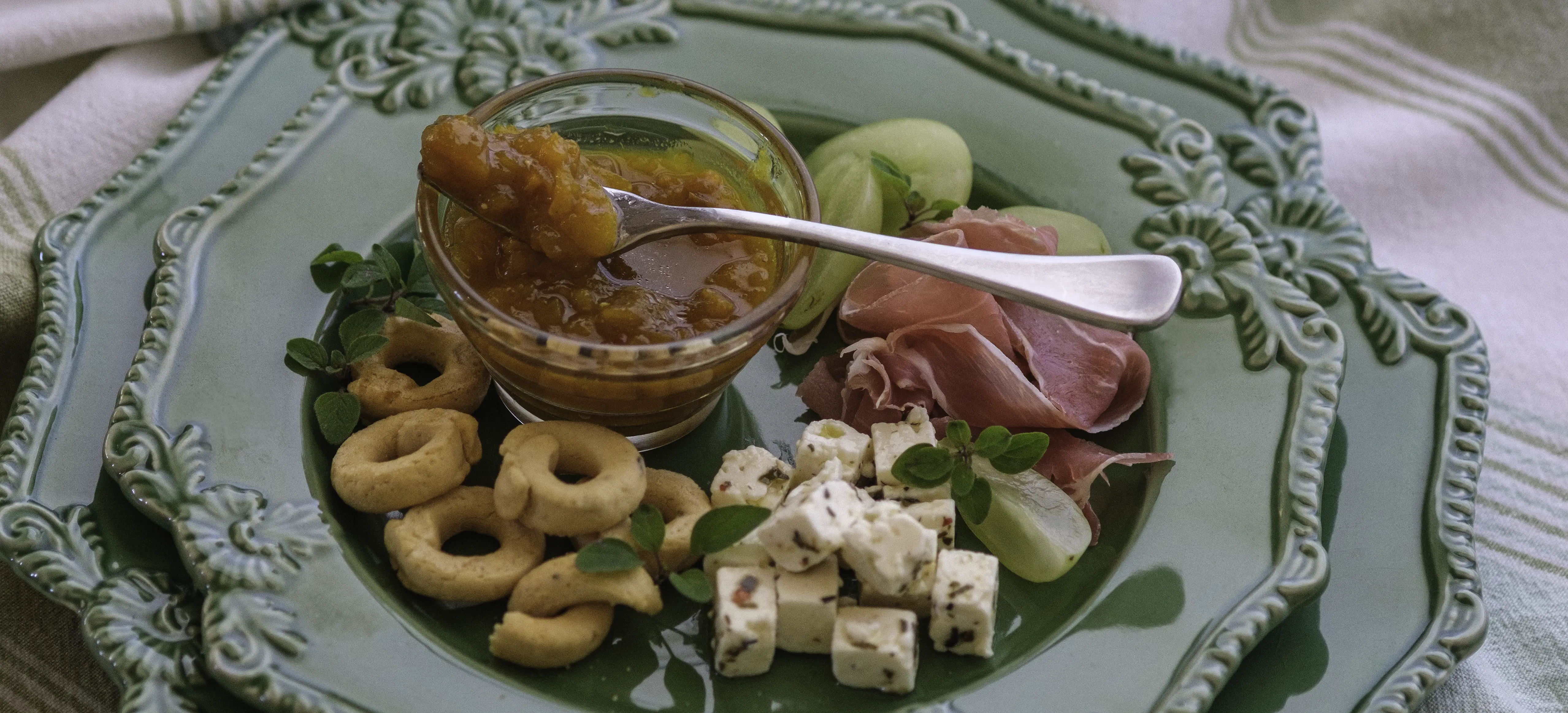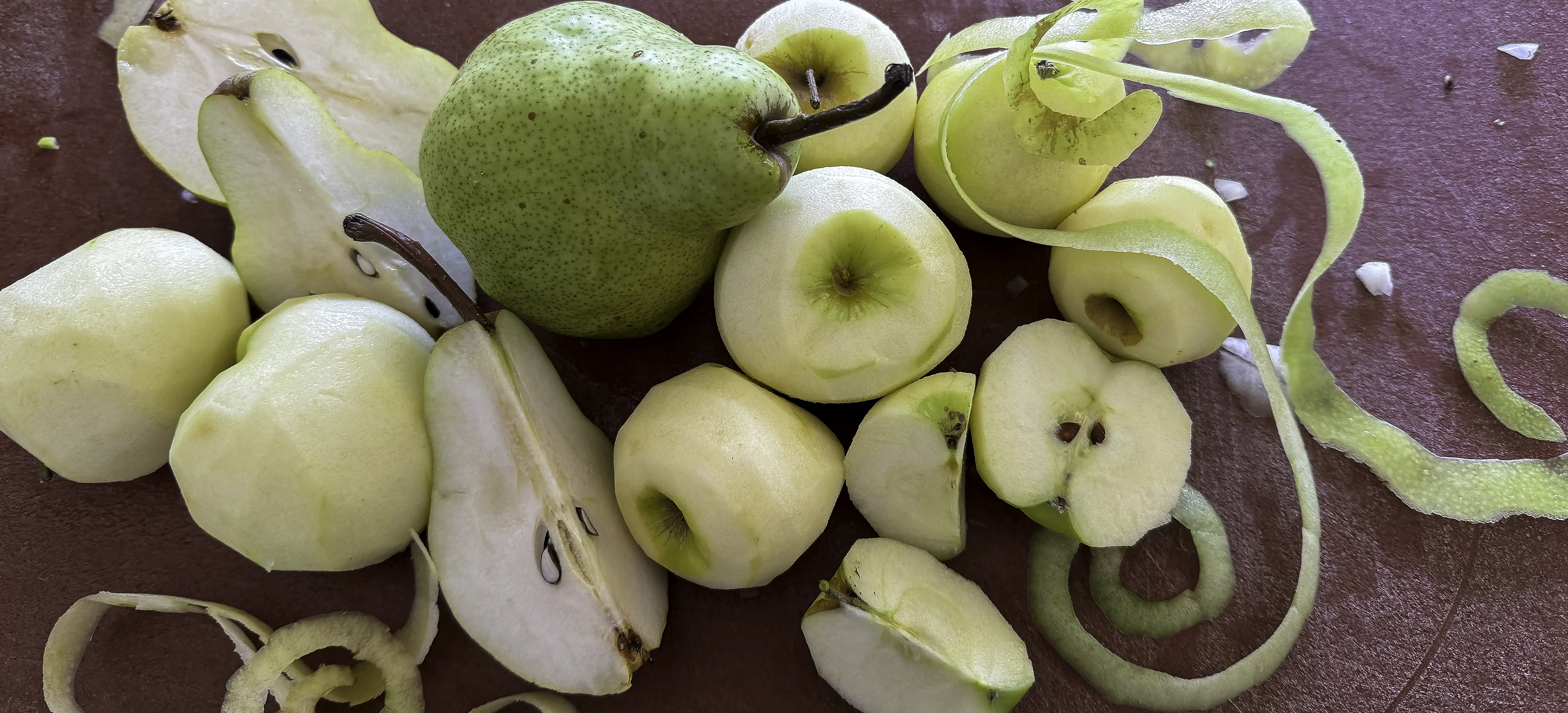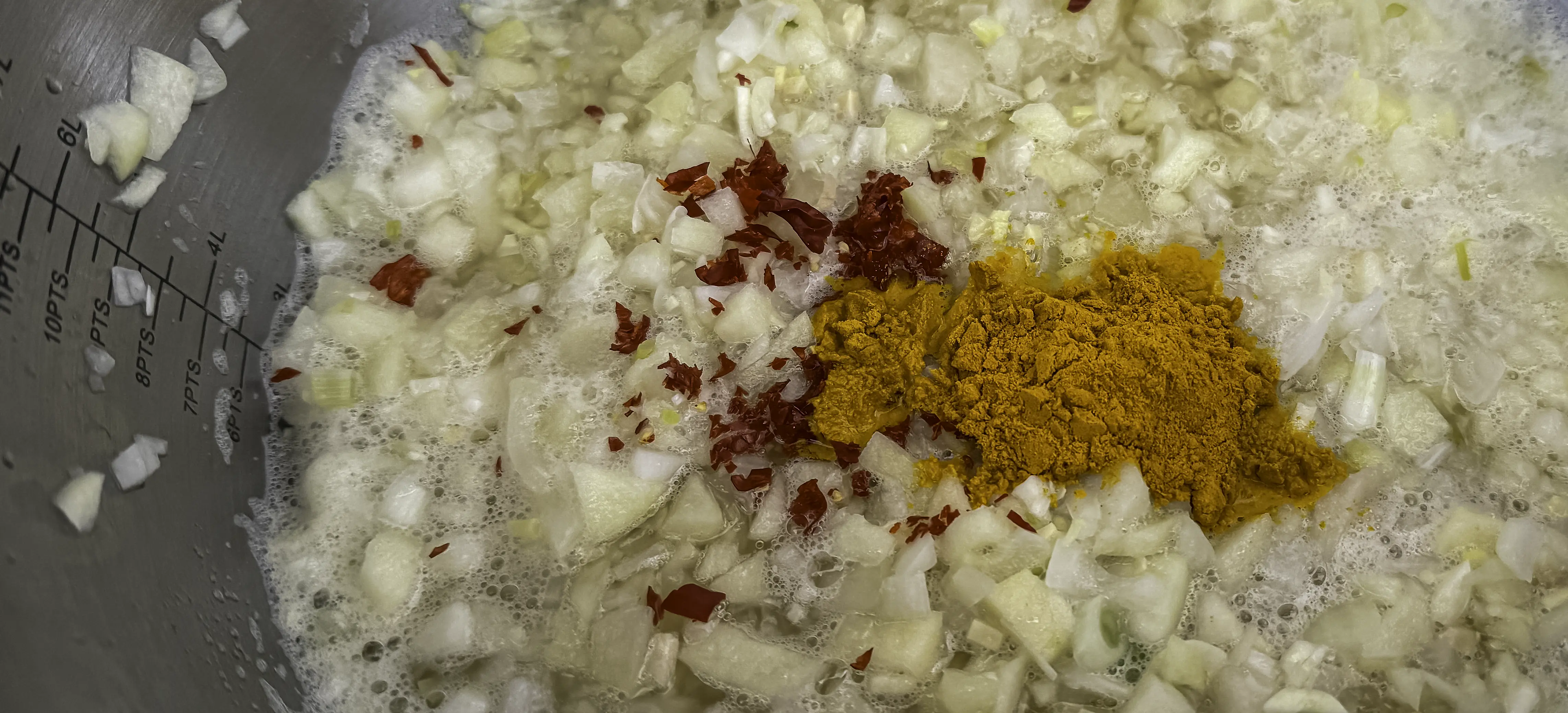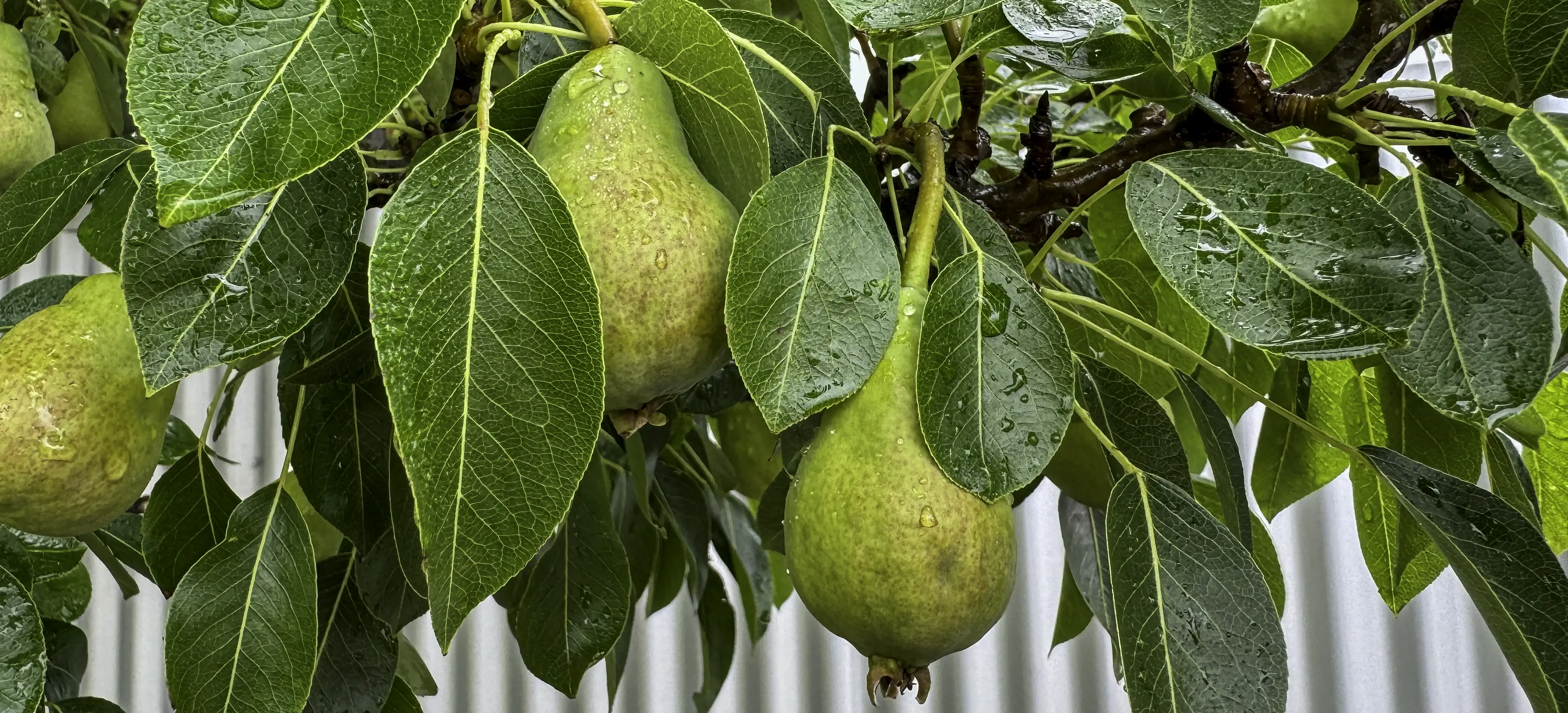Golden Apple and Pear Chutney
- Pickles, Chutney, Relish & Sauces

This light and fruity chutney, with just enough chilli and garlic to spark up the taste buds, looks magnificent on the plate. It’s a great introduction to those that haven’t made chutney or relish before. This no-fuss technique produces such a fabulous accompaniment you will get hooked on making homemade preserves. As autumn approaches turn your windfalls into an economical chutney, or if the harvest is abundant, make a batch of this golden delight to break up your preserving tasks from making other seasonal preserves. This is delicious! Spread lavishly !
- Preparation Time:
- 45 minutes
- Cooking Time:
- 60 minutes
- Quantity:
- 6 x 250ml jars
PREPARATION
Sterilise glass jars and lids that have a protective lining. Have the jars and lids hot, dry, and ready for the bottling stage. Refer to my article How to Sterilise Jars and Bottles for more information article.

INGREDIENTS
- 900g
- Green cooking apples
- 900g
- Cooking pears, ripe
- 800g
- Brown onions
- 4
- Garlic gloves medium
- 2
- Red chillies, dried
- 60g
- Fresh ginger, peeled
- 1 litre
- Apple cider vinegar
- 550g
- White sugar
- 2 tablespoons
- Turmeric powder
- 1 teaspoon
- Salt

METHOD
Gently wash and dry the apples and pears to remove any garden or shop dust and/or debris. Remove any bruised or damaged areas.
Peel, core and roughly chop the apples and pears. Discard the cores and skin.
Remove the skin from the brown onion and finely chop. Peel and grate or finely chop the ginger.
Place the chopped apple, pear, onion, ginger, and chopped chilli in a large stainless steel preserving pan or heavy bottom stainless steel pot. Add the vinegar, sugar, turmeric, and salt and stir well to combine the ingredients.
Gently bring to the boil, stirring occasionally until the sugar has dissolved, then bring to the boil and turn down to a simmer. Cook for approximately 1 hour or until the mixture has a thick jammy consistency.
Stir occasionally to prevent it from catching and burning on the bottom of the pan.
Remove from heat and place on a heat-resistant board and allow the relish to cool slightly.
Use a funnel to ladle the relish into hot dry sterilised screw capped sealable bottles, fill to approximately 2.5cm (1 inch) from the top of the jar and seal with hot dry lids. This is the HHH method of sealing - hot preserve, hot dry jar with a hot dry lid.
Allow to cool and wipe the jars down to remove any spills during the bottling stage.
Label and store in a cool dark place in the kitchen or pantry. Allow to mature for at least 4 weeks before eating.
Once opened, store in the fridge and use within 3-4 months.
NOTES
- Good quality jars should be used in all preserving, particularly when they are processed in a hot water bath. Thin jars often cannot withstand the hot temperatures required and may crack either in the bath or on /after removal. Avoid the disappointment and invest in good jars from a homewares or preserves outlet. Select jars that have non-reactive lids as the vinegar solution can cause the lids to rust over time.
- Choose clean ripe fruit. Do not use overripe and never use mouldy produce as this will produce a poor-quality preserve.
- If you want a chunkier chutney style, cut the fruit into larger pieces.
- To ensure even cooking and consistency cut them all to the same size.
- Salt
- Use good quality pickling salt when making pickles and preserves. Many commercial salt brands contain stabilisers and anti-caking agents and often iodide which forms a whitish haze and sediment. These additives and in particular iodine can affect the appearance and taste of pickles and preserves during the maturation and storage period.
- The ingestion of a cocktail of anti-caking chemicals such as calcium silicate, sodium silicoaluminate, tricalcium phosphate, magnesium carbonate, silicon dioxide and yellow prussate of soda, is also unnecessary.
- Read the label before buying and look for salt that is free from any artificial additives. My favourite salt is Olsson Cooking Salt.
- No commercial benefit is received from Olsson Salt.
- Cooking times are an approximation only. They are provided as a guideline as cooking times are influenced by the type of pot and its diameter and height, speed of cooking and the ripeness, size, and moisture level of the vegetables used.
- Cooking time will depend upon:
- The size of preserving pan - the broader the pan the quicker the evaporation
- Degree of produce ripeness – the riper the produce, the sweeter and juicier the initial preserve will be.
- The degree of heat when cooking – the higher the heat, the greater the boil which will produce greater evaporation.
- Cooking time will depend upon:
- HHH Method
- Seal the relish while it’s hot with hot dry lids. The HHH method of HOT dry jars, HOT dry lids and HOT chutney creates a vacuum seal as it cools. The “popping” sound, often heard in the kitchen, signals a successfully vacuum sealed jar.
- The HHH method of sealing is preferred as there is reduced risk of contamination prior to sealing. For further information refer to my article How To Sterilise Jars and Bottles
- Types of sugar & vinegar
- The type and colour of the sugar and vinegar used will affect the final colour and flavour of the preserve.
- Malt vinegar and brown sugar will produce a dark brownish red preserve with a more earthy/molasses background flavour, while white wine or apple cider vinegar and white sugar will produce a fresher and brighter flavour.
- This is a matter of personal choice; however, a well-made chutney should have a bright vibrant colour.
- Take care to only use vinegar which has a 5% minimum acetic acid content. This acts as the principal preservative, and a lower percentage will compromise the safety of your preserves. Most commercially available vinegar is 5%, however most homemade vinegars do not achieve this level. Check the brands label or the customer service site for the acetic acid content.
- Handling chillies
- It’s important to wash your hands thoroughly after handling and de-seeding chillies. Chilli oil is easily transferred from the chillies to hands.
- If you touch your eyes or any delicate areas, the chilli oil will be transferred on contact and create an uncomfortable burning sensation.
- Chutney consistency. Spoon a little of the mixture on to a plate, the chutney should hold its shape and have a jammy consistency.
- What’s the difference between a relish and chutney?
- A relish is usually made with fruits that are cut into smaller pieces, more frequently made with white or cider vinegar, and it’s generally made with a lower proportion of vinegar and sugar and cooked for a shorter time. This results in a lighter flavour with a fresher, crisper consistency.
KNOW YOUR SPICES
- Garlic (Allium sativum)
- Raw garlic has a sharp acrid taste, however when cooked it takes on a sweeter flavour and is not overpowering. It has the unique ability to heighten the flavour of the ingredients it’s combined with and is indispensable in the kitchen. Interestingly though, the way garlic is prepared will affect its flavour profile.
- There are two types of garlic- hardneck and softneck. Hardnecks grow with a stem that comes from the centre of the bulb and when harvested and cured, the stem becomes rigid and easily identifiable when pulling the cloves off. Softnecks have leaves rather than a central stalk, so there is no rigid stem in the middle of the bulb.
- Fresh garlic should be stored in loose netting or a basket in a cool, dry, and well-ventilated place. Do not store in a paper bag. Garlic’s flavour, pungency and moisture content will deteriorate over time.
- Dried garlic and garlic powder are available and should be stored in an airtight container.
- Ginger (Zingiber officinale)
- Ginger has a hot-spice, citrusy woody taste. It’s available as a fresh underground stem, a rhizome, as a finely ground powder and preserved in sugar. The dried and preserved versions are used in baking.
- Dried ginger is also used in spice blends whereas fresh ginger is widely used in Asian cuisine. Do not substitute dried ginger for fresh, when specified in a recipe, as the dried form has a stronger and more aromatic flavour.
- When purchasing fresh ginger, avoid older rhizomes with signs of shrivelling as the plant is drying out and the flesh can be fibrous.
- Turmeric (Curcuma longa)
- Turmeric is a leafy tropical plant of the ginger family. The fresh leaves are used as a herb or to wrap foods in. However, the rhizome (root), used either fresh or dried as a powder, is more widely known. I
- t has a woody, floral, bitter flavour and works particularly well in complex blends where its pungent flavour acts as a foundation which binds the other flavours together. It’s often used to colour recipes with an intense yellow colour.
- If too much is used by itself, its bitter notes can be overwhelming.

